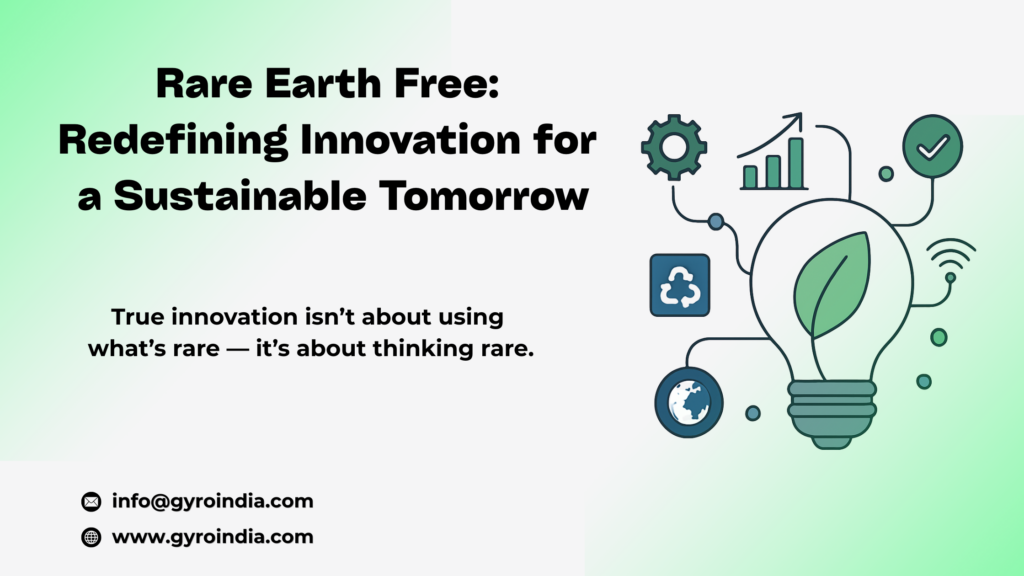Rare Earth Free: Redefining Innovation for a Sustainable Tomorrow
 Rare Earth Free: Redefining Innovation for a Sustainable Tomorrow
Rare Earth Free: Redefining Innovation for a Sustainable Tomorrow
If you’ve ever wondered what powers our modern world — from smartphones to satellites — you’ll find one thing in common: rare earth materials. They sound exotic, and they truly are, but they also come with a big environmental and economic cost. That’s where the idea of going Rare Earth Free steps in — a bold move that’s reshaping how industries think about innovation, efficiency, and sustainability.
Let’s dive into how this new wave of thinking is changing the future, one design at a time.
Why “Rare Earth Free” Matters More Than Ever
Rare earth materials, despite the name, aren’t exactly rare. They’re scattered all over the planet — just very hard and expensive to extract. Mining and processing them often create serious environmental challenges, from toxic waste to soil degradation. Plus, global supply chains rely heavily on a few countries, creating risks for industries that depend on these materials.
Now imagine a world that’s Rare Earth Free — where we design smarter, using alternative materials and technologies that deliver the same performance with fewer compromises. By moving away from dependence on rare earths, companies gain more freedom, flexibility, and resilience. You, as a consumer, benefit too — with products that are cleaner, greener, and often more affordable.
Going Rare Earth Free isn’t just a technical shift; it’s a mindset that connects sustainability with practicality. It’s about asking, “Can we build better without taking more?”
Innovation Through Limitation: The New Creativity
When engineers are told they can’t use rare earth materials, something fascinating happens — innovation explodes. Without the crutch of conventional resources, companies start experimenting with fresh designs, materials, and processes. It’s like being given a puzzle with missing pieces and still managing to create a masterpiece.
This approach is sparking new breakthroughs across industries. From eco-friendly magnets to next-generation energy systems, Rare Earth Free innovation is proving that necessity truly is the mother of invention. When limitations appear, creativity grows stronger — and the results are often surprisingly efficient.
For big brands and startups alike, the challenge is no longer “how to find rare earths,” but “how to do more without them.” This shift is not only improving product reliability but also opening doors for cost reduction and local material sourcing. That means less dependence on global supply chains and more stability in uncertain times.
Sustainability Meets Smart Business
Going Rare Earth Free is not just good for the planet — it’s great for business. Companies that adopt sustainable design early often gain a competitive edge. They attract eco-conscious customers, reduce production costs, and future-proof their operations against supply disruptions.
Think of it as long-term insurance for innovation. By cutting reliance on rare earths, businesses become less vulnerable to market volatility and environmental regulations. Instead of reacting to resource shortages, they’re leading the change.
And here’s the best part: being sustainable no longer means sacrificing performance. Thanks to advancements in material science and digital design, many Rare Earth Free technologies now perform on par with traditional ones — sometimes even better. That’s a win-win situation for both manufacturers and users.
The future belongs to companies that see sustainability not as an obligation but as an opportunity to innovate smarter and grow stronger.
The Road Ahead: A Future Without Compromise
We’re living in a time when every decision — big or small — affects the planet. Choosing to go Rare Earth Free is one of those rare opportunities to make a meaningful difference. It’s about rethinking how we design, produce, and consume without draining limited natural resources.
Of course, the transition won’t happen overnight. There are challenges to overcome, from material research to large-scale adoption. But the direction is clear — and inspiring. Step by step, companies, researchers, and consumers are proving that sustainable innovation is not a trend, but a transformation.
At its heart, Rare Earth Free innovation is about balance — combining human creativity with environmental responsibility. It’s about creating a future where technology thrives in harmony with nature, not at its expense.
So the next time you hear about a product that’s Rare Earth Free, remember — it’s not just about materials. It’s about the mindset behind it: designing responsibly, thinking long-term, and believing that progress doesn’t have to cost the planet.
Conclusion: Reinventing Innovation for a Better Tomorrow
Being Rare Earth Free isn’t just an engineering choice — it’s a philosophy that connects innovation with conscience. It proves that sustainability can be smart, creative, and profitable all at once.
As industries evolve and technology races ahead, the real heroes will be the innovators who dared to ask one powerful question:
“How can we create more — by taking less?”
That’s the future. That’s Rare Earth Free

Leave a Reply